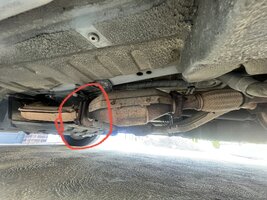Some fail in a way in which the front honeycomb melts and blocks.
But we know that they often fail in a way in which the honeycomb breaks up because after a front cat failure if rear cats are in place there's loads of front cat material blocking the entrance to rear cats... Following a front cat failure if rear cats are still in place, if the front end of the rear cat is disconnected from the front pipe section it's normal to see various sized chunks of cat ceramic honeycomb material, lots of dust and bits of fluff come out from the front end of the rear cat.
The front cat bodies (in fact all cat bodies including rear cats) are wider than the incoming and outgoing exhaust pipe, there is an upside down funnel shape from the incoming exhaust to the cat body, the wider (than exhaust pipes) cat body, then at the bottom of the cat a narrowing correct way up funnel shape to the exit pipe. The internal cat material is brittle, easily cracked and broken up into smaller pieces, and in the process creates lots of white ceramic dust. I reckon that some front cat blockages are caused by broken up cat material blocking the narrowing exit funnel shape and smaller broken up pieces / dust blocking any gaps between bigger pieces, there's also a lot of heatproof padding/fluff like material sealing the interface between the ceramic core and the metal body which (if we imagine a chunk of ceramic broken away from the outer edge near the padding/fluff) can come loose and help to block any small gaps between big chunks of ceramic blocking the exit.
I've decored many Elgrand rear cats and a few front cats, really brittle stuff, removed by tapping into it with something like a chisel which splits it and then (on the short nearside rear section that doesn't have to be cut open to decore it) you end up with lots of dust and loose chunks inside the cat that won't come out of the exhaust inlet or exit hole until you've broken the bits into progressively smaller pieces. Bits can get wedged in an inlet / outlet hole even without trying, sometimes difficult to free by intense shaking etc, seems reasonable that with exhaust gas all trying to flow one way through a cat with broken bits of various sizes, dust and padding/fluff inside all trying to be pushed out of the exit that the exit can get blocked up and the stuff blocking the exit compacted and made even more gas tight by the exhaust pressure.

